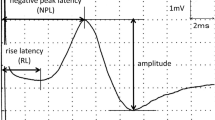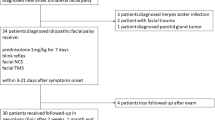Summary
The muscle action potential evoked by the facial nerve stimulation was investigated in 31 normal subjects and in 122 patients with facial palsy. The normal finding of this nerve conduction study was described in detail, and the results of the qualitative and quantitative analysis of the nerve conduction patterns obtained from the patients were presented. The following conclusions were derived from the present study.
-
1.
The duration, size, threshold, latency, and relationship between the response and the stimulus intensity were the important factors involved in the diagnosis of the denervation in the facial nerve.
-
2.
On the basis of the analysis of these factors, the grade of denervation could be differentiated into no denervation, slight denervation, moderate denervation, and severe denervation. The prognosis of the palsy largely depended upon the grade of denervation.
-
3.
The nerve conduction study could reveal minor denervation which might be overlooked by the conventional nerve excitability measurement and
-
4.
In the cases with moderate or severe denervation, decompression surgery facilitated earlier and better recovery of the facial movements.
-
5.
The nerve conduction study was proved to be a valuable adjunct to the conventional nerve excitability measurement, S-D curve, and electromyography. The prognosis of facial palsy as well as the indication of surgical treatment could be established by careful evaluation of the results of different electrodiagnostic examinations including nerve conduction study.
Zusammenfassung
Das Muskelaktionspotential, hervorgerufen durch Stimulation des Facialisnerven, wurde bei 31 normalen Personen and bei 122 Patienten mit Facialisparese untersucht.
Der Normalbefund dieser Nervenleitungsuntersuchung wird im Detail beschrieben und die Resultate der qualitativen und quantitativen Analyse der Nervenleitungsmuster von den Patienten werden vorgelegt. Folgende Schlußfolgerungen werden aus der vorliegenden Untersuchung abgeleitet:
-
1.
Die Dauer, Größe, Schwelle, Latenz und das Verhältnis zwischen Reaktion und Stimulusintensität waren die bedeutenden Faktoren für die Diagnose der Denervation des Facialisnerven.
-
2.
Auf der Grundlage der Analyse dieser Faktoren könnte der Grad der Denervation differenziert werden in: fehlende, schwache, mäßige und schwere Denervation. Die Prognose der Lähmung hing weitgehend vom Grad der Denervation ab.
-
3.
Die Nervenleitungsuntersuchung kann schwächere Denervationsformen auf-decken, welche bei der konventionellen Messung der Nervenerregbarkeit und der S-D-Kurve übersehen warden.
-
4.
Bei Fällen mit mäßiger oder schwerer Denervation erleichtert die Dekompressionsoperation die frühere und bessere Erholung der Gesichtsmotilität.
-
5.
Die Nervenleitungsuntersuchung hat sich als eine wertvolle Ergänzung der konventionellen Nervenerregbarkeitsmessung, der S-D-Kurve and der Elektromyographie erwiesen. Die Prognose der Facialislähmung und die Indikation zur chirurgischen Behandlung können gesichert warden durch eine sorgfältige Berechnung der Resultate der unterschiedlichen elektrodiagnostischen Prüfungen einschließlich der Nervenleitungsprüfung.
Similar content being viewed by others
References
Alford, B. R.: Electrodiagnostic studies in facial paralysis. Arch. Otolaryng. 85, 259 (1967).
Asakura, H.: Clinical investigations on peripheral facial palsy. Pract. Otol. (Kyoto) 62, 1237 (1969).
Buchthal, F.: Electromyography in paralysis of the facial nerve-general aspects. Arch. Otolaryng. 81, 463 (1965).
Campbell, E. D. R.: A simple prognostic test in facial palsy. J. Laryng. 77, 462 (1963).
−, Hickey, R. P., Nixon, K. J., Richardson, A. T.: Value of nerve excitability measurements in prognosis of facial palsy. Brit. med. J. 2, 7 (1962).
Cawthorne, T., Wilson, T.: Indication for intratemporal facial nerve surgery. Arch. Otolaryng. 78, 429 (1963).
Cohen, H. L., Brumlik, J.: A manual of electroneuromyography. New York: Hoeber Medical Division 1969.
Collier, J.: Electrodiagnosis and surgical indications in facial palsy. Arch. Otolaryng. 78, 421 (1963).
Currier, W. D.: Effects of electronic stimulation of the VII nerve. Ann. Otol. (St. Louis) 72, 289 (1963).
Feinstein, B.: Application of electromyography to affections of the facial and the intrinsic laryngeal muscles. Proc. roy. Soc. Med. 39, 817 (1946).
Giancarlo, H. R., Kenneth, F. M.: Facial palsy, facial nerve decompression. Arch. Otolaryng. 91, 30 (1970).
Gilliatt, R. W., Taylor, J. C.: Electrical changes following section of the facial nerve. Proc. roy. Soc. Med. 52, 1080 (1959).
Hiestand, P., Kaeser, H., Kocher, R., Pfaltz, C. R.: EMG und Facialisdekompression bei Bell'scher Lahmung. Pract. oto-rhino-laryng. (Basel) 31, 144 (1969).
Hilger, J. A.: Facial nerve stimulator. Trans. Amer. Acad. Ophthal. Otolaryng. 68, 74 (1964).
Isono, H., Asakura, H.: Early surgical indication in facial palsy. Pract. Otol. (Kyoto) 60ZZ, Suppl. 2, 78 (1967).
Jongkees, L. B. W.: Bell's Palsy: A Surgical emergency? Arch. Otolaryng. 81, 497 (1965).
−:Tests for facial nerve function. Arch. Otolaryng. 89, 153 (1969).
Lambert, E. H.: Diagnostic value of electrical stimulation of motor nerve. Electroenceph. clin. Neurophysiol., Suppl. 22, 9 (1962).
Laumans, E. P. J.: Nerve excitability tests in facial paralyses. Arch. Otolaryng. 81, 478 (1965).
−, Jongkees, L. B. W.: On the prognosis of peripheral facial paralysis of endotemporal origin. Part II. Ann. Otol. (St. Louis) 72, 621 (1963).
Loebell, E.: Untersuchungen über die Reizleitungsgeschwindigkeit in Nervus Facialis. Z. Laryng. Rhinol. 44, 685 (1965).
Matsunaga, K., Hazama, H., Sakamoto, M., Tamaoki, H., Iida, M.: Evoked electromyography in facial palsy. Pract. Otol. (Kyoto) 60, 1047 (1967).
Mawson, S. R.: Diseases of the ear (second edition). London: Edw. Arnold Ltd. 1967.
McGovern, F. H.: The use of the nerve excitability test in paralysis of the facial nerve. Laryngoscope (St. Louis) 76, 955 (1966).
McHugh, H. E.: Facial paralysis and muscle ageneses in the newborn. Arch. Otolaryng. 89, 157 (1969).
Minowada, Y.: Clinical investigations on facial palsy. Pract. Otol. (Kyoto) 62, 1309 (1969).
Nagakura, M.: Electromyography studies in postoperative facial palsy. Jap. J. Otol. (Tokyo) 69, 1616 (1966).
Parsons, R. C.: Electrical stimulation of the facial nerve. Laryngoscope (St. Louis) 76, 391 (1966).
Richardson, A. T.: Electrodiagnoses of facial palsies. Ann. Otol. (St. Louis) 72, 569 (1963).
Seddon, H. J.: Three types of nerve injury. Brain 66, 237 (1943).
Shambhaugh, G. E., Jr.: Surgery of the ear (second edition). Philadelphia: W. B. Saunders Comp. 1967.
Sullivan, J. A.: Surgical techniques of the facial nerve. Arch. Otolaryng. 78, 434 (1963).
Taverner, D.: Bell's palsy a clinical and electromyographic study. Brain 78, 209 (1955).
Taverner, D.: Electrodiagnosis in facial palsy. Arch. Otolaryng. 81, 470 (1965).
Tozuka, G., Hirose, H., Kobayashi, K.: Postoperative facial palsy, its electromyographic finding. Pract. Otol. (Kyoto) 60, 1033 (1967).
Wigand, M. E.: Die Prognose der idiopathischen (Bellschen) Fazialisparese bei electromyografischer Indiationsstellung zur Dekompressionsoperation. Z. Laryng. Rbnol. 46, 439 (1967).
−, Spreng, M., Bumm, P.: Computer-Analyse von Facialis-Elektromyogrammen I: Acta oto-laryng. (Stockh.) 66, 296 (1968).
Yanagihara, N., Kishimoto, M.: Significance of electrodiagnosis in facial palsy. Pract. Otol. (Kyoto) 62, 561 (1969).
Author information
Authors and Affiliations
Rights and permissions
About this article
Cite this article
Yanagihara, N., Kishimoto, M. Nerve conduction study in facial palsy. Arch. Klin. Exp. Ohr.-, Nas.- U. Kehlk. Heilk. 198, 339–349 (1971). https://doi.org/10.1007/BF00316934
Received:
Issue Date:
DOI: https://doi.org/10.1007/BF00316934




